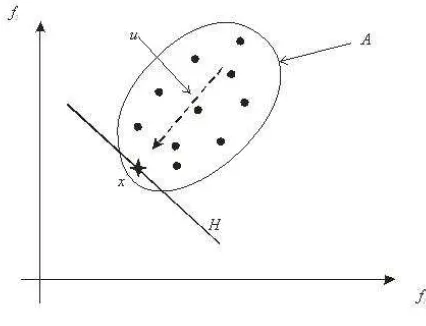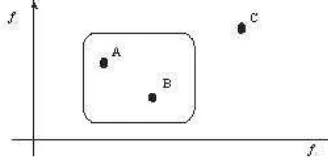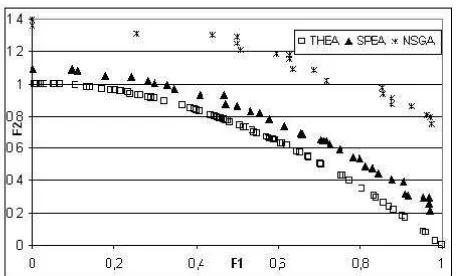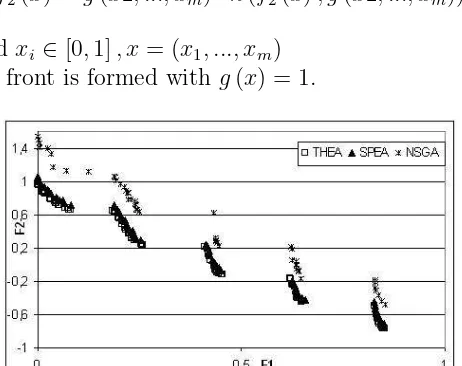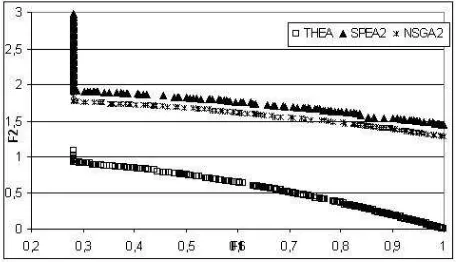OPTIMIZATION USING AN EVOLUTIONARY HYPERPLANE GUIDED APPROACH
Corina Rotar, Dan Dumitrescu and Rodica Lung
Abstract. A new evolutionary technique for multicriteria optimization called Target Hyperplane Evolutionary Algorithm (THEA) is proposed. The originality of the approach consists in the fact that the fitness assignment is realized by using a guiding hyperplane and a new non Pareto optimality concept. THEA has been tested on consecrated benchmarks.
Keywords: Evolutionary Computation, Multicriterial Optimization.
1. Introduction
In the last decades, multicriterial optimization has been a fertile ground in the field of evolutionary computation. Various evolutionary techniques have been successfully developed and applied on complex multicriterial optimization problems. Nevertheless, the subject is still a real challenge for the researchers in the field of evolutionary algorithms both with regard to developing new methods and with the analysis, comparison and evaluation of algorithms per-formances. A new evolutionary technique for multicriterial optimization called Target Hyperplane Evolutionary Algorithm (THEA) is proposed. THEA in-troduces a new non Pareto fitness assignment procedure based on guiding hyperplanes providing an intuitive form of guidance towards the desired front for the population.
2. Target Hyperplane Evolutionary Algorithm
Two well-known issues arise regarding population dynamics within evo-lutionary algorithms: the first refers to preserving population diversity as an important factor for the success of the search process and the second one refers to the convergence towards the problem solutions. Moreover, for complex prob-lems such as multicriteria optimization probprob-lems, the balance between the two mentioned components is compulsory. Our main goal is to produce an efficient population dynamics with respect to both diversity and convergence aspects.
Consider the following n objectives minimization problem:
minimizeF(c) = f1(c), ..., fn(c)
c∈D (1)
where:F :D→Rnand D ∈Rm
The use of a hyperplane to guide the search in the objective space is sug-gested. The guiding hyperplane is built such that the most individuals in the current population are dominated by hyperplane points. Two characteristics of the current population are used to construct the hyperplane:
• An ideal vector in the objective space that is better with regard to every component than all individuals in the current population;
• The most important direction along which the population is spread out in the objective space.
This hyperplane is updated every generation according to the configuration of the current population.
Such a hyperplane would guide the population towards promising areas of the search space. The movement of the population guided by the hyperplane ultimately leads to convergence to the Pareto front.
The guiding hyperplane which is built for each generation is called the target of the current generation.
focusing on the production of offspring closer to the target and not necessar-ily on the convergence to the Pareto front. However, the manner of building the target hyperplane for the current population leads to convergence to the Pareto front without using a performance function based explicitly on the Pareto dominance concept.
Regarding the diversity preservation, the target hyperplane can also be used to estimate the diversity degree of the current population. Thus, projecting the individuals of the present population on the target hyperplane could provide an image of the population’s distribution. In order to maintain a good distribution during the search process THEA is supplemented with a mechanism that favors increased search in the areas poor in individuals of the search space.
Two measures are associated to each individual in the current population: the first one refers to the distance to the target hyperplane and the second refers to the agglomeration degree of its projection in the guiding hyperplane. Both measures are used to set the balance between exploring and exploiting, which is so necessary for obtaining a good population dynamics.
The mechanism of replacing parents with offspring is designed in such a way as to accelerate population convergence, i.e. to favor the survival of the best solutions found.
2.1. Guiding hyperplane construction
The objective function values corresponding to the current population may be considered as a cluster A = (α1
, α2
, ..., αd) of n-dimensional points. This cluster can be described by means of principal components analysis used in classification theory.
Let m be the mean vector (the centroid) of set A. The most important directions along which cluster Ais spread out are given by the eigenvectors of the scatter matrix S, given by
S = d X
i=1
αi−m
αi−mT (2)
Eigenvectors of the matrix S are called the principal directions of the cluster A [2].
The eigenvector u corresponding to the largest eigenvalue gives the most important direction along which the cluster is spread out.
Denote by x0
x0i = min
[image:4.612.185.398.145.308.2]aki |k ∈ {1,2, ..., d} , i∈ {1,2, ..., n} (3)
Figure 1: Construction of hyperplane H
Each component x0
iof vector x
0
is given by the minimum value of the com-ponents ak
i of the vectors ak ∈A. Thus x
0
represents an ‘ideal’ vector formed with the best components from the vectors of A. The aim is to guide the search of populationAtoward what could be called the most promising region provided by it. Thus the hyperplaneHorthonormal to directionuand passing though x0
is constructed:
H :uT x−x0= 0 (4)
Hyperplane H characterizes the set A and it will be considered to be the target of the current population in the objective space. Hyperplane H will be used to evaluate individuals.
2.2. Hyperplane based fitness assignment
Each generation of the evolutionary process, the current target hyperplane
H is constructed. Current solutions are evaluated using H. Two features characterize an individual:
• µ2- measuring the crowding degree its neighborhood .
Consider an individual c in the current population P(t) and α= (f1(c), ..., fn(c)).
We denote µ1 : D → R the function computing the distance between individualc and the target hyperplaneH:
µ1(c) =d(H, α) (5)
It is essential to maintain the diversity of the cluster. The population will explore efficiently the search space if individuals from less crowded zones will be promoted to survive and evolve. A measure for the degree of crowdedness of a point into its vicinity is proposed. A simple function to evaluate the crowdedness is proposed.
We denoteµ2 :D→Rthe function by which an individualcin the current population can be qualified regarding the crowdedness. Letc′ be the projection
of cinto the target hyperplane H. Function µ2 is given by:
µ2(c) = min{d(c′, c′k), ck ∈P (t)} (6)
Thus µ2 represents the minimum of the distances between the projection of individualc intoH and all other projections from the current population.
Remark. Euclidian distance is used.
2.3.Computing next generation. Very weak optimality concept.
THEA uses binary tournament selection and two genetic operators for vari-ation: crossover and mutation. Offspring obtained by using crossover form an intermediary population P1, while descendents obtained by mutation will be
included into a second intermediary populationP2. Selection for recombination relies on the closeness to the hyperplane (µ1), while the crowdedness into the target hyperplane (µ2) gives the fitness values for the selection for mutation. A
Figure 2: Solutions represented by the points A and B are weakly optimal. Solution C does not verify the weak optimality condition
A new optimality concept called very weak optimality condition for multi-criterial optimization problems is proposed.
Definition 1. Let us consider problem (1) and denotea and b two solu-tions from A⊆D, a, b∈A.We say that a is weakly better than b and we write
a⊲b if there is at least one objective fi such that fi(a)< fi(b). Remark. Note that a⊲b does not exclude the relation a⊳b.
Definition 2. Let a be a solution from A⊆D. We state that a is weakly optimal with regard to the set A if we have:
∀b ∈A, a⊲b, which can be also written:
∀b∈A,∃i∈ {1,2, ..., n} |fi(a)< fi(b)
Figure 2 illustrates the introduced weak optimality concept. Several two dimensional points (individuals) are considered. The weakly optimal solutions are plotted in a box.
We denote by P1(t) the population of descendents obtained by crossover,
and by P2(t) the population of descendents obtained by mutation. The three populations are combined to form a larger population Γ (t) = P(t)∪P1(t)∪
P2(t). Each individual c from Γ (t) is evaluated using the following function
of performance:
Thus the performance of an individual is given by the number of individuals from the population Γ (t), against which it is better in at least one objective.
The best individuals from Γ (t) regarding the performance measure replace the current population P(t),resulting the next generation P(t+ 1).
Target Hyperplane Evolutionary Algorithm (THEA) is described in the following.
Target Hyperplane Evolutionary Algorithm
1. Randomly generate initial population P(0), t=0.
2. Compute the target hyperplane H for the current population P(t). 3. Establish the population P′(t)representing the projections of solutions fromP(t) onto the target hyperplane H.
4. Evaluate the population P(t) regarding the target H. 5. P1(t) := Crossover(P(t))
6. P2(t) := M utation(P(t))
7. Construct population Γ (t) = P(t)∪P1(t)∪P2(t).
8. Evaluate the population Γ (t) by using the proposed performance func-tion Φ.
9. Replace the current population P(t) with the best distinct individuals of the population Γ (t); t := t+1.
10. If stopping condition is true then stop, else go to step 2.
In order to confer THEA a better generality a different mutation mech-anism is proposed. The mutation operator may act in two ways: uniform mutation of a single gene or uniform mutation of all genes, depending on a randomly generated parameter that decides which type of mutation will be applied further.
3. Numerical experiments
Some results obtained using THEA are presented. The well-known test suite of bi-criterial functions ZDT1-ZDT3, ZDT6 [4] is used in order to inves-tigate the performance of the proposed algorithm.
We shall treat the two subsets differently when applying variation opera-tors. Thus the probability of selecting a gene also depends on the subset that includes it. More specific X1 will be given a higher probability for mutation.
The change in the genetic mutation operator positively affects the conver-gence of the population, drastically reducing the number of generations needed for the population to locate the Pareto front. For example: considering the test function ZDT6, defined for 100 decision variables, giving a probability of 0.1 to the first variable to be altered, as compared to 0.001, - the probabil-ity conferred by the standard option of the mutation - the convergence time improves sensibly. In order to avoid loading the algorithm with additional parameters, we chose random generation for each application of the mutation operator, of a probability that the selected gene corresponds to a variable from the first or second subset of decision variables. Figures 3-6 illustrate the results obtained by THEA against those provided by two other evolutionary techniques for multiobjective optimization: SPEA [3] and NSGA [5]. The fol-lowing evaluation metrics were used: Coverage metric [7] and Spacing metric [8]. Solutions plotted in the figures 2-4 are obtained after a single run of the considered algorithms. The main parameters are:
THEA’s main parameters SPEA, NSGA’s main parameters Population size = 80 Population size = 100
Maximum number of generation =100 Maximum number of generation =250
Problem ZDT1 presents a convex Pareto front:
f1(x) =x1 g(x2, ..., xm) = 1 + 9·
n P i=2
xi
m−1
h(f1, g) = 1−qf1
g
f2(x) =g(x2, ..., xm)·h(f2(x), g(x2, ..., xm))
Figure 3: Solutions obtained by THEA, SPEA and NSGA for problem ZDT1.
f1(x) =x1 g(x2, ..., xm) = 1 + 9·
n P
i=2
xi
m−1
h(f1, g) = 1−f1
g 2
f2(x) =g(x2, ..., xm)·h(f2(x), g(x2, ..., xm))
where m=30 and xi ∈[0,1], x= (x1, ..., xm)
The true Pareto front is formed with g(x) = 1
Figure 4: Solutions obtained by THEA, SPEA and NSGA for the test problem ZDT2. Entire final population of the THEA algorithm is close to the true Pareto front.
[image:9.612.182.410.402.540.2]f1(x) =x1 g(x2, ..., xm) = 1 + 9·
n P i=2
xi
m−1
h(f1, g) = 1−qf1
g − f1
g ·sin (10πf1)
f2(x) =g(x2, ..., xm)·h(f2(x), g(x2, ..., xm))
where m=30 and xi ∈[0,1], x= (x1, ..., xm)
[image:10.612.180.411.165.348.2]The true Pareto front is formed with g(x) = 1.
Figure 5: Solutions obtained by THEA, SPEA and NSGA for the test function ZDT3
The values for the considered metrics are summarized next.
Coverage Zdt1 Zdt2 Zdt3 Coverage Zdt1 Zdt2 Zdt3
C(Spea,THEA) 0 0 0 C(Nsga,THEA) 0 0 0
[image:10.612.96.498.447.495.2]C(THEA,Spea) 1 1 0.85 C(THEA,Nsga) 1 1 1
Table 1. Coverage metric - Comparison’s results between THEA and other popular algorithms: SPEA and NSGA on the test function considered
Spacing Zdt1 Zdt2 Zdt3 THEA 0,0163 0,0106 0,0098
Regarding the more recent and improved SPEA2 and NSGA2 [1], [6] a series of numeric experiments were made. We present next the results obtained for the ZDT6 test problem. For an objective view concerning the performances of the algorithms the following remarks are made:
- The algorithms NSGA2 and SPEA2 use a population size of 100 in-dividuals. The maximum number of evaluations allowed is 100000.
- THEA uses a base population of 100 individuals for 100 generations. - For each algorithm, solutions found in 30 runs were unified and Pareto dominated solutions were removed.
Figure 5 illustrates the Pareto nondominated solutions found by THEA, SPEA2 and NSGA2 after 30 runs. Without any further numerical comparison, it is obvious that THEA outperforms the other algorithms for the considered test function. THEA’s number of fitness evaluation is smaller then 100000 evalua-tions. Even if the base population size is 100 individuals, a larger population of descendents and parents is evaluated regarding the very weak Pareto opti-mality concept, therefore the fitness evaluation number if larger than 100x100, but still less than 100.000 which is the maximum number of fitness evaluation allowed for the other two algorithms. Maximum number of fitness evaluations for a single run of the algorithm THEA is 30.000.
Problem ZDT6:
f1(x) = 1−exp (−4x1) sin6
(6πx1)
g(x2, ..., xm) = 1 + 9· n P i=2
xi
m−1
h(f1, g) = 1−
f1
g 2
f2(x) =g(x2, ..., xm)·h(f2(x), g(x2, ..., xm)) where m=100 andxi ∈[0,1], x= (x1, ..., xm)
The true Pareto front is formed with g(x) = 1.
4. Conclusions
Figure 6: ZDT6. THEA versus SPEA2 and NSGA2 - solutions found by each algorithm in 30 runs. Only Pareto nondominated solutions are plotted
As far as the main features of a good approximation of the Pareto front are concerned, i.e. diversity and convergence, two evaluation functions are used to facilitate the evaluation of each solution regarding the closeness to the current target hyperplane and regarding the crowdedness of the solutions’ projections into the hyperplane. The target hyperplane guides the search gradually until the Pareto front is found.
Experimental results show that the approach performs well in various static optimization problems. The target hyperplane, which guides the current pop-ulation toward the Pareto front together with the new concept of optimality, form an efficient procedure for solving the multicriterial optimization problem. The proposed algorithm performs better than well-known algorithms for the selected set of test problems. It outperforms SPEA and NSGA for the test suite ZDT1-ZDT3, ZDT6 regarding the closeness to the Pareto front. Generally, SPEA algorithm provides a better-distributed set of solutions.
THEA algorithm also outperforms improved algorithms SPEA2 and NSGA2 for problem ZDT6. Consequently, we can assert that THEA is efficient for solving multicriterial optimization problems.
References
[2] R. Duda, Hart, P., Pattern recognition and scene analysis,Wiley- Inter-science, New York, 1974.
[3] N. Srinivas, K. Deb, Multiobjective Optimization Using Nondominated Sorting in Genetic Algorithms, Evolutionary Computation 2(3): 221-248 (1994)
[4] E. Zitzler, K. Deb, and L. Thiele, Comparison of multiobjective evolu-tionary algorithms: Empirical results, Tech. Rep. 70, Comput. Eng. Networks Lab. (TIK), Swiss Federal Inst. Technol. (ETH) Zurich, Switzerland, Feb. 1999.
[5] E. Zitzler and L. Thiele, An Evolutionary Algorithm for Multiobjective Optimization: The Strength Pareto Approach, Technical Report 43, Computer Engineering and Communication Networks Lab (TIK), Swiss Federal Institute of Technology (ETH) Zurich, Gloriastrasse 35, CH-8092 Zurich, May 1998.
[6] E. Zitzler, M. Laumanns, and L. Thiele,SPEA2: Improving the Strength Pareto Evolutionary Algorithm Technical Report 103, Computer Engineering and Communication Networks Lab (TIK), Swiss Federal Institute of Technol-ogy (ETH) Zurich, Gloriastrasse 35, CH-8092 Zurich, May 2001.
[7] E. Zitzler, K. Deb, and L. Thiele, Comparison of Multiobjective Evolu-tionary Algorithms: Empirical Results, EvoluEvolu-tionary Computation, 8(2), pages 173-195, 2000.
[8] J. R. Schott, Fault Tolerant Design Using Single and Multicriteria Ge-netic Algorithm Optimization, Master’s thesis, Department of Aeronautics and Astronautics, Massachusetts Institute of Technology, Cambridge, Mas-sachusetts, May 1995.
Authors: Corina Rotar
Department of Computer Science
”1 Decembrie 1918” University of Alba Iulia N. Iorga 11-13 Alba Iulia
e-mail: [email protected] Dan Dumitrescu
Department of Computer Science
Rodica Lung
Department of Computer Science
